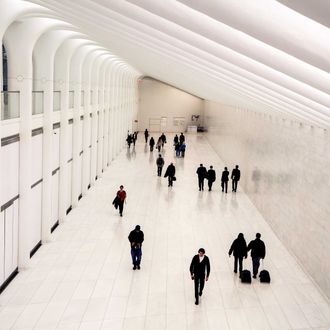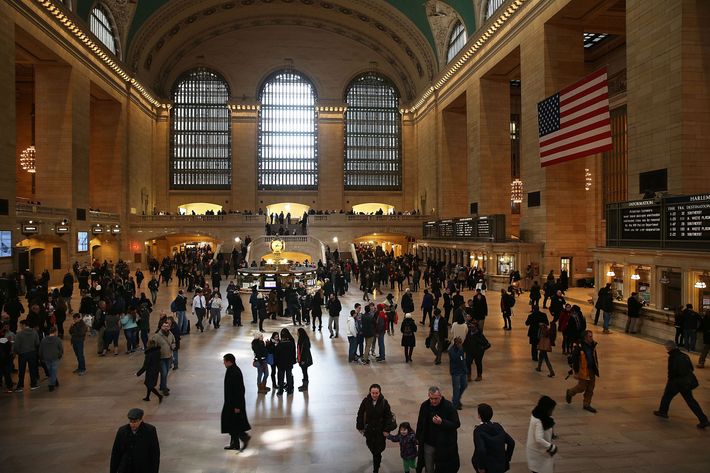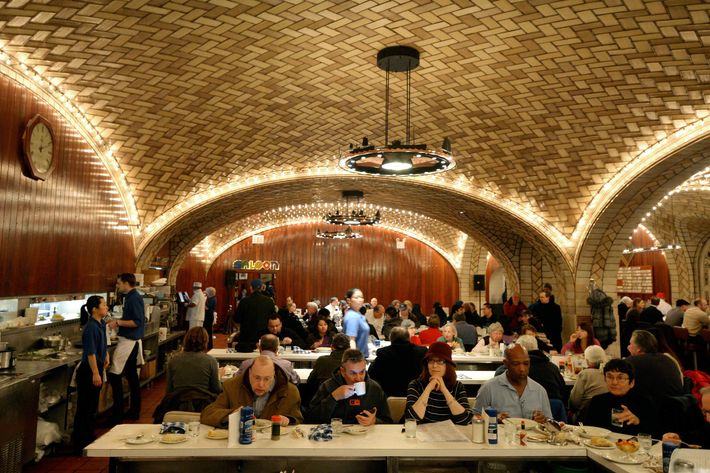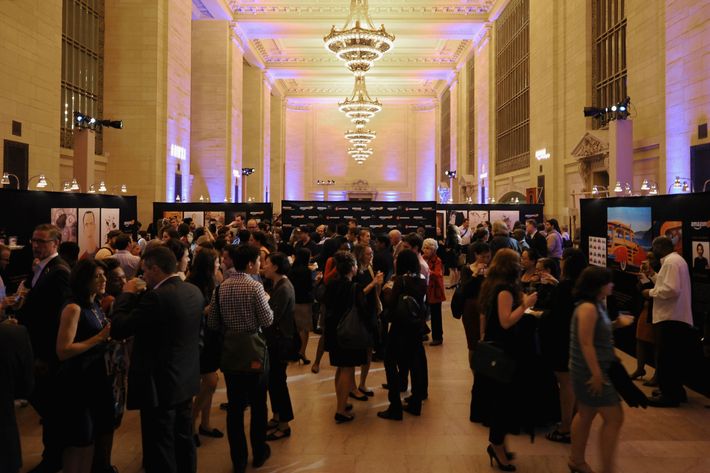
(Note: The audio samples within this story are best heard through headphones.)
I recently emerged slightly stunned from the Picasso sculpture show at the Museum of Modern Art and, not quite ready to tear myself from the world of the imagination, lingered at the edge of the high-walled atrium on the second floor. Light streamed in agreeably from the sculpture garden. Visitors trooped up the stairs, past the high black granite wall. Suddenly, my anxiety level began to rise, for no discernible reason. Then I noticed that the noise level had snuck up from a background hum to a threatening rumble. Voices ricocheted off the hard floors and walls so that I could no longer find their source. I glanced over the glass railing to the lobby below, where a tour leader was trying to get the attention of his chattering charges, who raised their voices in response to block him out. In seconds the contest drew in other unwitting participants, escalating into a murky din. That out-of-control reverberation distilled everything that’s wrong with MoMA: the crowds, the coldness, the train-station feel.
The experience made me wonder whether New York’s next actual train stations will sound any more inviting. The massive white-ribbed vault of Santiago Calatrava’s World Trade Center Transportation Hub opens early next year. Eventually, Skidmore, Owings & Merrill’s glass-tented hall for Moynihan Station will straggle into existence too. Will the billions spent on infrastructure buy us places we actually want to be — places that are gentle on the ears? Part of the answer lies in the computers of Cerami & Associates, an acoustical-engineering firm that simulates the ambiance of unbuilt spaces (including the Transportation Hub and Moynihan Station) and calculates how intelligible a public announcement will be.
A room’s sound is a subliminal quality that we only rarely notice but that produces a visceral reaction. Concert halls are designed to make music sound clear but also to give it body and warmth — qualities that have measurable characteristics. But they are profoundly artificial environments, packed with sound-absorbing audiences, with the sound originating from predictable locations. In rooms that are meant for living rather than just listening, the conditions are more complex. We use our ears to orient ourselves, to gauge an indoor space’s size and purpose. We listen for clues about how long to stay and how quickly to move. A room that’s too dead and dry can feel enervating, as if happiness had suddenly been pulverized into a layer of dust. A space that’s too live, where a sound goes slamming against its own reflection, can be disorienting. Being unable to tell where a noise is coming from feels like being dazzled by glare, like being the victim of a hostile act. We tend to react exactly wrong in such aggressively reverberant rooms: Instead of all dropping our voices to an intimate murmur, we raise them to compete, which only adds to the murk. That’s why in so many restaurants with low ceilings and concrete tables, one diner with a hearty laugh can tip a pleasant hum into a group roar.
To get a better appreciation of how we experience big public rooms with our ears, I asked Raj Patel, an acoustical engineer at the global firm Arup, to join me in the Main Concourse of Grand Central Terminal, one of the most acoustically pleasing spots in New York. We talked quietly beneath the zodiac ceiling far above, enveloped by a soft cushion of chatter and clicking feet. Occasionally a spoon clinked against a cup on the mezzanine level a block away from where we stood. The noise ricocheted off the café’s marble wall and sped toward us, clear and uncontaminated by echoes, so that I instinctively turned toward its source. That crystalline ping mixed with sounds that drifted up to the ceiling and fluttered back down in a soft haze. Or else they wandered off through archways, got trapped beneath balconies, or scattered against the ornamental foliage.

“From an acoustical standpoint you’re effectively outside,” Patel says. “The energy coming back down is weak — just enough to give you a sense of ambience.”
Not every space within the station is the same. On a lower level, the famous “whispering arch” passes the vibrations of a murmur along the rib from one corner of a vault to the other. With its low vaults, the Oyster Bar is loud, but it would be intolerable if not for the porous Guastavino tiles that drink in some of the hubbub and turn it into a bit of heat. Just outside the restaurant’s glass doors, the ceiling looks the same but sounds completely different: Here the tiles are reflective, and even a casual comment acquires a churchlike boom.

Patel and I step into Vanderbilt Hall, a great oblong room where at charity events the speaker’s amplified voice goes pinballing around smooth walls and flat ceiling, blurring consonants and slurring vowels. We hear each sound not just once but in a high-speed rat-tat-tat of repetitions. Listen to an announcement from a subway-station loudspeaker: If echoes hit your eardrum about 25 milliseconds after the original consonant, before quickly tapering off, then you’ll understand the message. But if the echoes keep going for 50 milliseconds or more, you can make out only “Attention, pa … ” before the message devolves into metallic mush.

The modern science of acoustics began in 1895, when Harvard students whose classes met in the Fogg Museum lecture hall complained that they had no idea what the professor was saying. The task of fixing the problem fell to a junior physics professor, Wallace Clement Sabine, who raided the seat cushions from a far better auditorium, Sanders Theatre, hauled them over to the offending hall each night, and rushed them back by the start of morning classes.
In the 1920s, though, design split off from the science of sound. Instead of specifying plaster, terra-cotta, wood, and porous stone, architects preferred concrete, steel, and glass, which return reflections in flat, harsh bursts. Soon, acoustical engineers developed a whole technology of illusion. Sounds could be manipulated — dampened, boosted, and redirected, or all at once. Amplification allowed for bigger rooms. Absorptive materials turned echoey spaces into dry ones. The modernist pursuit of straight lines, smooth surfaces, and seamless clarity naturally yielded its opposite in sound: turbid cacophony. The engineers at Cerami walked me through some techniques developed to compensate for architecture’s acoustic deficiencies. Some are electronic: focusing a beam of amplified sound so that it doesn’t go banging against hard walls. Others involve disguising absorptive materials — for example, studding glass with high-tech microscopic perforations.
At MoMA in 2004, the architect Yoshio Taniguchi delivered a building of hard minimalist purity, and our ears have suffered the consequence. Yet another new MoMA is on the way: Diller Scofidio + Renfro are designing its expansion into the base of Jean Nouvel’s tower next door, tackling some of the existing building’s miseries at the same time. This time, Cerami will help. The company’s CEO, Victoria Cerami, hadn’t quite appreciated the challenge until she went to visit MoMA’s education wing, where her firm was planning to throw itself a 50th-anniversary party. “How ironic that an acoustics firm should celebrate in such an acoustically awful space,” she said.
Audio clips courtesy of Arup.






























